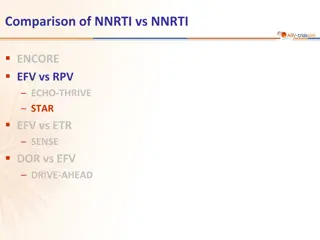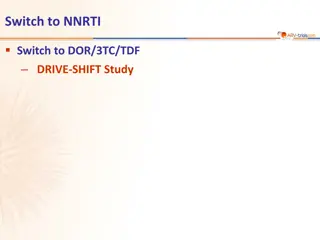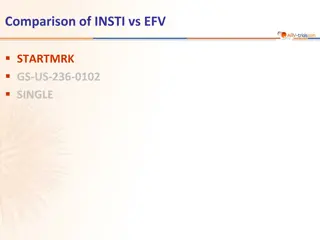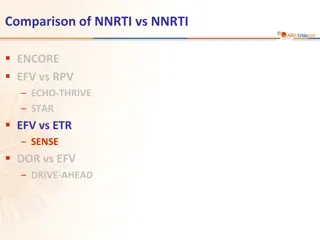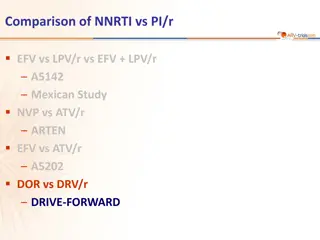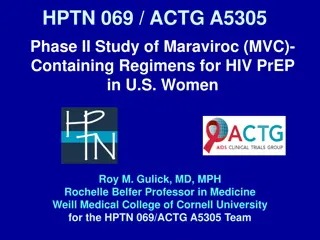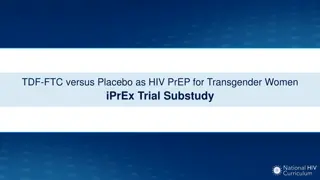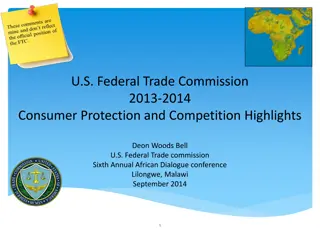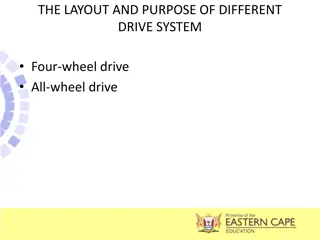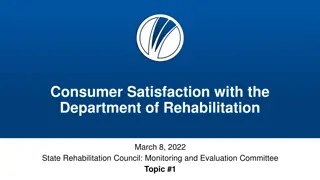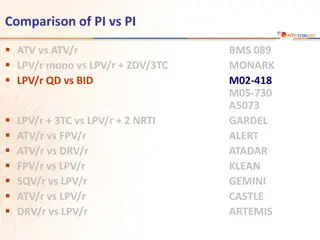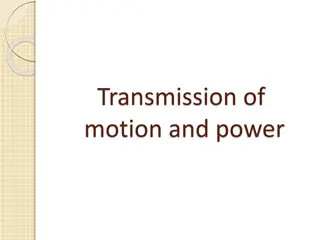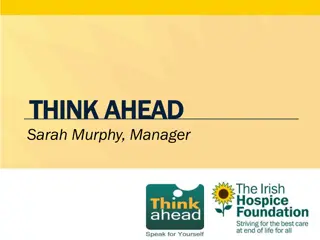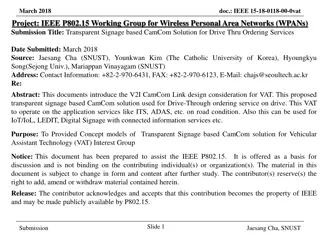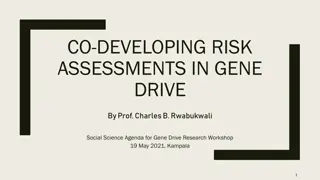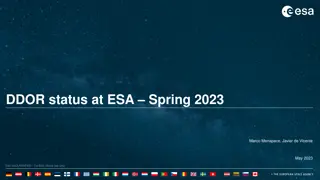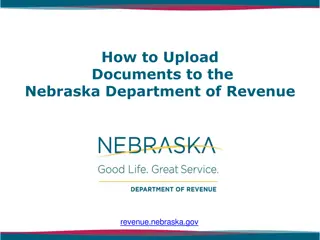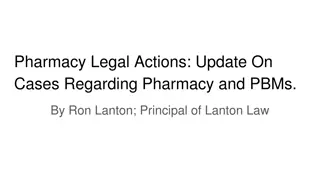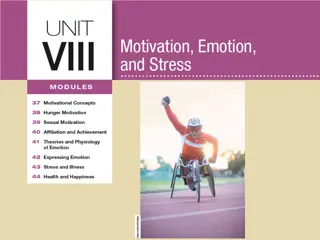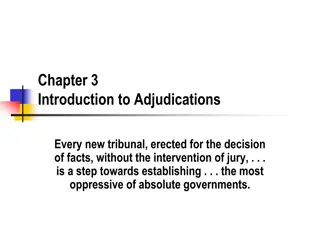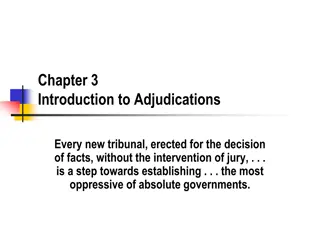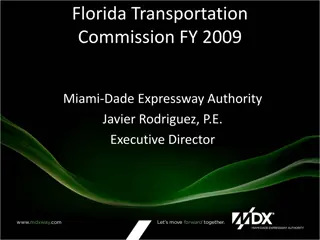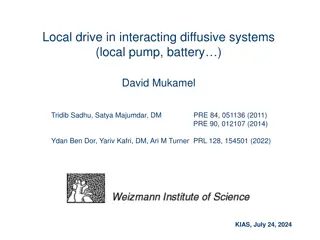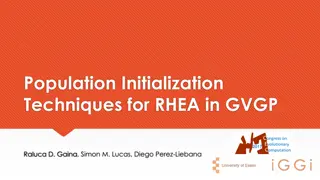Comparison of NNRTI vs NNRTI and DRIVE-AHEAD Study: DOR/3TC/TDF vs EFV/FTC/TDF
The comparison study explores NNRTI regimens alongside the DRIVE-AHEAD trial, focusing on DOR/3TC/TDF vs EFV-FTC/TDF. DRIVE-AHEAD assesses the efficacy and safety of DOR in ARV-naïve HIV patients, aiming for non-inferiority based on virologic response, with DOR exhibiting potential neuropsychiatric advantages. Baseline data and patient outcomes, including discontinuation rates and virologic responses, are presented at Week 48 and Week 96. Results indicate comparable virologic suppression and CD4 count improvements between DOR and EFV regimens at both time points.
Download Presentation

Please find below an Image/Link to download the presentation.
The content on the website is provided AS IS for your information and personal use only. It may not be sold, licensed, or shared on other websites without obtaining consent from the author. Download presentation by click this link. If you encounter any issues during the download, it is possible that the publisher has removed the file from their server.
E N D
Presentation Transcript
Comparison of NNRTI vs NNRTI ENCORE EFV vs RPV ECHO-THRIVE STAR EFV vs ETR SENSE DOR vs EFV DRIVE-AHEAD
DRIVE-AHEAD Study: DOR/3TC/TDF vs EFV/FTC/TDF Design Randomisation* 1 : 1 Double-blind W48 W96 > 18 years ARV-na ve HIV RNA > 1 000 c/mL Any CD4 cell count eGFR (CG) 50 mL/min No primary resistance to DOR, EFV, NRTI N = 364 DOR 100 mg/3TC/TDF QD + placebo EFV/FTC/TDF + placebo N = 364 * Randomisation was stratified by HIV RNA (< or > 100 000 c/mL) at screening and chronic hepatitis B or C DOR/3TC/TDF : 1 tablet QD as STR Objectives Non inferiority of DOR at W48: % HIV RNA < 50 c/mL by intention to treat, snapshot analysis (lower margin of the 95% CI for the difference = - 10%, 90% power) Superiority of DOR for neuropsychiatric adverse events by W48 DRIVE-AHEAD Orkin C. Clin Infect Dis. 2019 ;68:535-44
DRIVE-AHEAD Study: DOR/3TC/TDF vs EFV/FTC/TDF Baseline characteristics and patient disposition DOR/3TC/TDF (N = 364) EFV/FTC/TDF (N = 364) Median age, years 32 30 Female, % 16 15 AIDS, % 13 15 HIV RNA (log10c/mL), mean HIV RNA > 100 000 c/mL, % 4.4 4.5 20 23 CD4 cell count (/mm3), mean 435 416 CD4 < 200/mm3, % 12 13 Discontinuation at W48, N (%) Lack of efficacy, N Adverse event, N Death, N Lost to follow-up / Consent withdrawal, N Non-compliance / Other, N 51 (14%) 18 10 1 6 / 8 1 / 7 61 (17%) 10 23 3 7 / 11 2 / 5 Discontinuation at W96 (N (%) Lack of efficacy, N Adverse event, N 68 (19%) 31 11 88 (24%) 23 26 DRIVE-AHEAD Orkin C. Clin Infect Dis. 2019 ;68:535-44
58 DRIVE-AHEAD Study: DOR/3TC/TDF vs EFV/FTC/TDF Primary endpoint: HIV RNA < 50 c/mL at W48 (ITT, snapshot) % DOR/3TC/TDF (N = 364) Difference (95 % CI) 100 EFV/FTC/TDF (N = 364) 84 81 EFV DOR 80 3.5 60 -2.0 9.0 40 20 11 10 9 + 10% 10% CD4 increase at W48 (ITT, NC = F) DOR: + 198/mm3 EFV: + 188/mm3 0 5 0 Virologic response Virologic non-response No data HIV RNA < 50 c/mL at W48 (observed failure approach) Baseline HIV RNA 100 000 c/mL: DOR: 90.6% vs EFV: 91.1 % Baseline HIV RNA > 100 000 c/mL: DOR: 81.2 % vs EFV: 80.8 % DRIVE-AHEAD Orkin C. Clin Infect Dis 2019; 68: 535-44
DRIVE-AHEAD Study: DOR/3TC/TDF vs EFV/FTC/TDF HIV RNA < 50 c/mL at W96 (ITT, snapshot) HIV RNA < 50 c/mL at W96 (Observed failure approach) DOR 83.7 EFV 85.9 % DOR/3TC/TDF (N = 364) EFV/FTC/TDF (N = 364) 100 All patients Baseline HIV RNA 100 000 c/mL > 100 000 c/mL Baseline CD4 200/mm3 > 200/mm3 86.9 71.0 87.5 79.7 77.5 80 73.6 60 65.0 86.2 82.1 86.4 40 Mean increase in CD4 at W96 DOR/3TC/TDF = + 238/mm3 EFV/FTC/TDF = + 223/mm3 20 0 Difference: 3.8% (95% CI: - 2.4 to 10,0) DRIVE-AHEAD Orkin C. Clin Infect Dis. 2019 ;68:535-44
60 DRIVE-AHEAD Study: DOR/3TC/TDF vs EFV/FTC/TDF Protocol-defined virologic failures (PDVF) at W48 Definition Non response: HIV RNA 200 c/mL at W24 or W36 or confirmed HIV RNA 50 c/mL at W48 Rebound: confirmed HIV RNA 50 c/mL after obtaining HIV RNA < 50 c/mL DOR /3TC/TDF (N = 364) EFV/FTC/TDF (N = 364) Virologic failure, N 22 (6.0%) 14 (3.8%) Non response / Rebound 6 16 4 10 Discontinuation without PDVF, N 35 50 Genotype successfully performed, N Primary NNRTI resistance Primary NRTI resistance 23 6 * 5 * 24 12 ** 5 ** * NNRTI mutations : Y188L; V106I, F227C; V106V/I, H221H/Y, F227C; F227C; V106A, P225H, Y318Y/F; V106M/T, F227C/R ; NRTI mutations : M41L, M184V; M184V; M184V; K65R; K65K/R, M184V ** NNRTI mutations : K103N; K103N, E138E/G; K103N; G190E; K103N; K103N, M230L; G190E; K103N, V108V/I, T369T/A/I/V; K103N; K103N; K101K/N, K103N, P225P/H ; NRTI mutations : V118I, M184V; M184V; M184V; M184V, K219K/E; K65K/R, M184M/I DRIVE-AHEAD Orkin C. Clin Infect Dis. 2019 ;68:535-44
DRIVE-AHEAD Study: DOR/3TC/TDF vs EFV/FTC/TDF Virologic failure and resistance, W96 DOR/3TC/TDF EFV/FTC/TDF (N = 364) (N = 364) D0-W48 W48-W96 D0-W48 W48-W96 Virologic failure, N (%) Non-response Rebound 34 (9%) 6 28 14 (3.8%) 4 10 28 (8%) 4 24 22 (6.0%) 6 16 Discontinuation without protocol- defined virologic failure, N (%) 35 (9.6%) 39 (11%) 50 (13.7%) 62 (17%) Genotype successful, N NNRTI major resistance NRTI major resistance 23 11 0 0 24 9 2 0 6 (1.6%) 5 (1.4%) 11 (3.3%) 5 (1.4%) DRIVE-AHEAD Orkin C. Clin Infect Dis. 2019 ;68:535-44
62 DRIVE-AHEAD Study: DOR/3TC/TDF vs EFV/FTC/TDF Adverse events at W48, % DOR/3TC/TDF (N = 364) 31 4 3 2 1 < 1 EFV/FTC/TDF (N = 364) 63 6 7 6 1 1 Drug-related adverse event Serious adverse event Discontinuation due to adverse event Drug-related Discontinuation due to serious adverse event Drug-related Adverse event in 10% in either group Headache Diarrhea Nasopharyngitis Dizziness Nausea Abnormal dreams Rash Grade 3-4 laboratory abnormalities Fasting LDL-cholesterol Fasting triglycerides Creatinine AST / ALT Lipase Creatine kinase 13 11 11 9 8 5 5 12 14 9 37 11 12 12 < 1 1 2 < 1 / 1 1 3 2 3 1 1 / 1 1 3 DRIVE-AHEAD Orkin C. Clin Infect Dis. 2019 ;68:535-44
DRIVE-AHEAD Study: DOR/3TC/TDF vs EFV/FTC/TDF % with Predefined Neuropsychiatric Adverse Events at W48 DOR/3TC/TDF EFV/FTC/TDF p < 0.001 % 40 37.1 p < 0.001 30 25.5 20 p = 0,033 12.1 10 8.8 8.2 6.6 4.4 4.1 1.1 0.3 0 Dizziness Sleep Altered sensorium Depression and suicide/ self-injury Psychosis and psychotic disorders disorders and disturbances DRIVE-AHEAD Orkin C. Clin Infect Dis. 2019 ;68:535-44
DRIVE-AHEAD Study: DOR/3TC/TDF vs EFV/FTC/TDF Fasting Lipids (mg/dL): change from Baseline at W48 25 22.0 21.8 DOR/3TC/TDF EFV/FTC/TDF p < 0,0001 20 p < 0,0001 15 13.3 10 8.5 8.7 5 1.9 0 -1.6 -2.0 -5 -3.8 -10 -12.4 -15 LDL-C Non-HDL-C Cholesterol Triglycerides HDL-C DRIVE-AHEAD Orkin C. Clin Infect Dis. 2019 ;68:535-44
DRIVE-AHEAD Study: DOR/3TC/TDF vs EFV/FTC/TDF Summary at week 48 In treatment-na ve adults with HIV-1 infection, DOR/3TC/TDF administered once daily demonstrated: Antiviral potency with non-inferior efficacy to EFV/FTC/TDF regardless of baseline HIV-1 RNA Low rate of resistance, with only 1.6% of participants developing resistance to any study drug through W48 DOR/3TC/TDF was generally well tolerated and safe: Neuropsychiatric profile superior to EFV/FTC/TDF, as measured by lower proportion of participants with neuropsychiatric adverse events in categories of dizziness, sleep disorders and disturbances, and altered sensorium Lipid profile superior to EFV/FTC/TDF, as assessed by difference from baseline in fasting LDL-C and non-HDL-C Summary at week 96 DOR/3TC/TDF continued to be non-inferior to EFV/FTC/TDF, with no additional emergence of resistance to DOR between W48 and W96 Rate of discontinuation for adverse event was lower with DOR/3TC/TDF (3% vs 7%) DRIVE-AHEAD Orkin C. Clin Infect Dis. 2019 ;68:535-44


